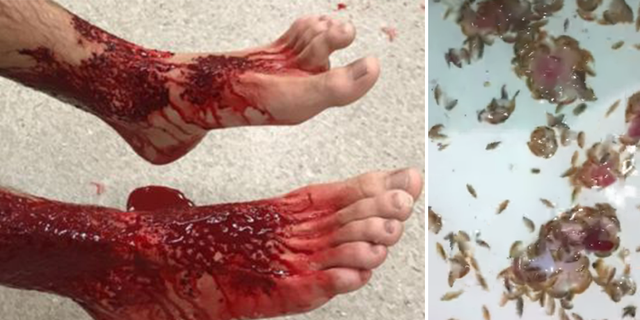After a tiring football game, 16-year-old Sam Kanizay just wanted to soak his aching legs in the water at the beach in Brighton, Australia. But the water wasn’t the respite he hoped—when he emerged a half hour later from the waist-deep water, his ankles were streaming blood, the BBC reports.
It “looked like a war injury,” his father told the news outlet. Kanizay took a shower to try to stop the bleeding, but the wounds weren’t clotting—and he kept bleeding.
Two hospitals in the area were unable to ID what caused the attack, so Kanizay’s father decided to go back to the beach and investigate himself. He dropped a hunk of raw steak in the water, and taped what happened next: Tiny, mite-like creatures swarmed the meat.
The creatures swarming the meat were likely amphipods, which are not known to bite humans, University of New South Wales professor Alistair Poore, Ph.D., told the New York Times. Just because they gathered around the meat Kanizay’s dad put in the water, that doesn’t prove that those creatures were the ones that bit Sam.
More likely: Oceanic parasites known as sea lice, which usually feed off fish, according to the New York Times. But these sea lice probably weren’t any more aggressive than they usually are—it just may be that there were more of them in the water than usual, which could be the case if there were lots of dead fish around, Poore said.
Sea lice aren’t an Australian thing—they live all over the world. But you don’t need to freak out: As the BBC reassures, such cases like Sam's are very rare. And even when sea lice do bite humans, they usually only leave an itchy, red rash.
Sea-bather’s eruption—which is sometimes erroneously referred to as sea lice, but is actually an allergic reaction to jellyfish larvae—can cause a similar rash after swimming, and is more likely to affect people. It’s common in waters off the Eastern coast of Florida and the Gulf of Mexico, especially from March to August, as we reported. Find out how you can treat the sting. (For more health news delivered right to your inbox, sign up for our Daily Dose newsletter.)













